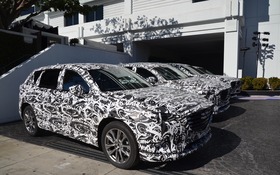2016 Mazda CX-9: Behind The Wheel Of A Camouflaged Prototype

| Strong points |
|
|---|---|
| Weak points |
|
Twenty-four hours before its official launch at the Los Angeles Auto Show, I had the opportunity to briefly drive a camouflaged prototype of the new Mazda CX-9. The test was very short, about 50 km mainly on highway 405 and down Mulholland Drive, but it nevertheless allowed me to appreciate the handling and performance of this seven-seat SUV. We’re looking forward to a more elaborate drive of the production model, which will likely be next spring, just before the vehicle hits showrooms in mid-2016.
Quiet on the set
The first thing we noticed as how quiet the CX-9 is, which really enhances passenger comfort. Engineers added 24 kilograms of sound-deadening material under the vehicle’s floor, the windshield and front side windows are thicker compared to the outgoing generation, and a noise cancellation system greatly contributes to keeping the cabin silent. All these modifications, which seem pretty effective, give us the impression that the vehicle is equipped with an automatic start/stop system, which isn’t the case. The CX-9 will probably be one of the quietest vehicles in its class.
Calibrated breathing
Instead of keeping the old V6 powertrain, engineers decided to add turbocharging to the 2.5-litre four-cylinder engine. The latter already equips the CX-5 and the Mazda6, and forced induction is a first for SKYACTIV engines. This new version benefits from a variable geometry turbocharger – which Mazda calls Dynamic Pressure Turbo – that can adapt itself to the degree of exhaust pulsation. At low rpm, the volume of the exhaust ports is reduced by a series of valves just before the exhaust gases reach the turbine, optimizing each pulsation. At higher rpm, the valves open up, allowing the turbine to be driven by a constant flow of exhaust gases.
To fully understand how all this works, we have to imagine ourselves holding a water hose. If we stick our thumb on the outlet, the force of the water stream is increased. That’s how Dynamic Pressure Turbo works at low rpm, when exhaust gases go through three small ports before directly reaching the turbocharger. When engine revs increase, a valve opens up and redirects exhaust gas flow through three larger-diameter ports, which equals to taking our thumb off the hose outlet and opening up the faucet.
On the road
So much for technical specifications, now on to the vehicle’s road manners. With its turbocharged engine, Mazda opted for low-end torque to the detriment of high-end horsepower. Simply put, engineers determined that most large SUV drivers rarely exceed 3,000 rpm, and that’s why the CX-9’s engine delivers a peak torque rating of 310 lb-ft between 2,000 and 4,000 rpm. As a result, the CX-9 is quick in everyday driving, and merging on the highway isn’t a problem, either, thanks to the generously available torque. The engine is rated at 250 hp using premium fuel, and 227 using regular unleaded, but the gasoline choice – and octane rating – doesn’t affect the torque peak.
On Mulholland Drive, a twisty road that includes many elevation changes, the CX-9 proved surprisingly agile despite its weight and size, proving this SUV fits right in with the company’s philosophy. Obviously, more time behind the wheel will be necessary to paint a more colourful portrait of the new CX-9, which we’ll be able to do right before the vehicle goes on sale. We’ll keep in touch.
The 2016 Mazda CX-9 unveiled at the Los Angeles Auto Show











